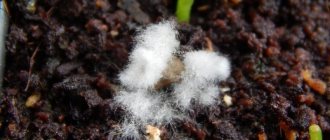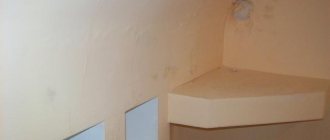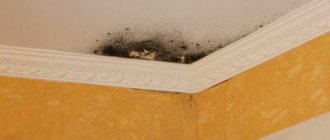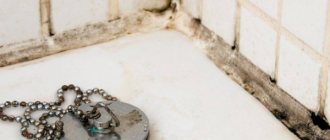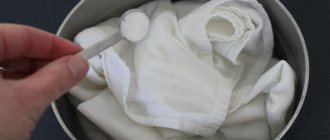This does not look aesthetically pleasing, leads to the destruction of materials, and is also quite dangerous for human health, because colonies of fungi can cause various diseases.
The causes of mold are commonplace: heat, excess moisture and lack of regular ventilation. The fungus is actively growing, occupying large areas.
You can stop this process without significant losses yourself by using complex methods of influence. We will tell you how to remove mold from plastic and wooden windows in this article.
Fungus and mold on windows: the main reasons for their appearance on plastic and wooden frames and slopes
The main factors why fungus and mold appear on windows and slopes:
- High humidity. In winter, the permissible norm is 30-40%. If the slopes and frames turn black, this indicates increased humidity of 60%. More often this problem occurs in the kitchen and bathroom, where there is a lot of moisture evaporation.
- High room temperature. In order for mold spores to “feel good” and actively reproduce, the air temperature should be 15-38 C°. The most optimal is 22-27 C°. Therefore, the recommended norm during the heating season for humans is 20-22 C°.
- Lack of ventilation. Plastic structures do not “breathe” and do not allow air to pass through, like wooden windows. The natural circulation of oxygen is blocked. Wood provides micro-ventilation. But if the residents of a house or apartment rarely ventilate the room, even if they have wooden windows, then this greatly increases the formation of mold on the slopes and along the perimeter of the window frame.
Important: All cracks, chips on wooden frames, gaps in joints or seams, as well as poor sealing of the glass unit allow cold air to pass through. And when it combines with the warm flow, condensation forms. And puddles on the window are an ideal place for mold.
The cracks create constant drafts
Fungus and mold on windows: additional causes of condensation
Let us repeat that constant moisture on windows leads to the growth of fungal spores. Plastic windows are more susceptible to this due to the tightness of the frame itself. But it is worth highlighting the reasons that many overlook, and they apply to any windows.
Additional reasons why fungus and mold appear on windows:
- Incorrect installation or assembly of the structure itself. That is, if there are cracks or emptiness between the frame and the wall, then there will be a constant draft in the house
- Insufficient layer of polyurethane foam. Or has it dried out over time?
- If the cleaning was initially done poorly and the foam did not stick well
- When the window sill is not used and water accumulates under the frame
- Distortion of the frame itself due to insufficient use of dowels or too wide a distance to the slopes
- If the window was installed directly on the insulation without wedges
- Gaps or cracks in the wall
- The window sill and slopes are too wide. A large window sill blocks the circulation of warm air from the radiators in order to properly dry the window from condensation
- Insufficient radiator/heating radiator
- The curtains are too thick, which also blocks the air to the window
A large number of flowers increases humidity and interferes with circulation
Fungus and mold on windows: control methods
You need to remove fungus and mold on windows according to the following scheme:
- Carry out a thorough cleaning of mold spores by washing
- If the fungus is very ingrained, you should use a brush, sandpaper, spatula or any sharp object. It is important to remove all deep stains, loose putty or damaged wallpaper.
- Dry the surface
- Use antifungal drugs or fungicides (list below)
- Some chemical solutions require that they be washed off with clean water. Therefore, read the instructions
- Dry the entire window area well with a building/household hairdryer, selecting a warm mode or another heating device
- If the mold is very “ingrained”, then the procedure can be repeated 2-3 times
- Waterproof the window frame - seal all seams and joints. Wooden windows can be covered with paper or cloth. But now you can use window sealant (acrylic, silicone, semi-sulfide, polyurethane) or special tape for both plastic and wooden frames.
Tip: Finally, you can diffuse a water solution of antiseptic essential oils, such as tea tree, clove, lavender or orange, grapefruit. But keep in mind - oils do not dissolve in water! First, 5-6 drops must be dissolved in 1 tbsp. l. alcohol and then mix with 100 ml of water. The proportions can be adjusted depending on the surface to be treated and the desired intensity of the solution.
Wipe off the mold thoroughly
Fungus and mold on windows and slopes: how to remove?
You can simply wipe off the fungus and mold on the windows, but on the slopes this is not enough. Firstly, it is not so easy to remove, and secondly, you need to fight the cause, not the consequences! Otherwise, disputes will return again, capturing new territories.
- It is necessary to completely dismantle the slopes and remove the window sill
- Thoroughly wash the entire area, treat with antiseptic preparations based on chlorine or biocide
- Fill large gaps with polystyrene foam and blow out cracks with foam. Don't forget to trim off any excess frozen areas. To guarantee, apply sealant
- Return all parts to their place. Putty the slopes, paint or cover them with the desired materials (plasterboard, plastic or MDF panels)
- Slopes can be waterproofed with a special mastic that does not allow moisture to pass through and protects against the proliferation of fungal spores. You can also use sealant or tape
Seal all the cracks!
Copper sulfate
A common and effective method. Copper sulfate is often used to combat fungus, but be aware that its corrosive properties can affect the appearance of the plastic. Having purchased vitriol, it must be diluted in water, it is advisable to use a metal container for this. Then apply the solution to the affected areas and let them dry. This method allows you to get rid of mold for many years.
How to remove fungus and mold on windows: a review of the best chemicals
You can buy a product to remove mold and mildew from windows at any hardware store. Moreover, they are suitable for working on any surface - concrete, brick, plasterboard, plaster or paint, ceramics, stone or wood. We offer a list of the best anti-mold drugs:
- Olympus stop mold
- Metas- BIO
- Tex
- NANO-FIX
- Abedis 06
- Fongifluid Alpa
- SCHIMMEL-ENTFERNER
- Dali
- Dufa
- Vincents Polyline
Review
You should be careful with plastic windows - against strong agents, and with prolonged exposure, the plastic may turn yellow. Therefore, it is better to choose the following means, since they are less aggressive:
- NEOMID Bio
- Biotsid-S
- Mellrud
- Tilex
- HG
Important : Take precautions, cover your eyes, head and hands! And always follow the instructions! Before purchasing, find out the degree of toxicity of the drug, whether it can be used indoors or on a certain surface, and how it affects animals.
Typically, chemicals are sprayed and removed along with the mold. If necessary, the procedure should be repeated to remove mold to the base. Then an antifungal primer is applied.
Treat every area
Ammonia
Ammonia is very effective for removing mold on plastic windows and glass. The mixture is diluted in a one to one ratio and applied to the contaminated surface using a spray bottle. After two hours, wash off with a sponge. When working with ammonia, you should ensure that the room is well ventilated and wear gloves on your hands, since alcohol vapors can cause vomiting, coughing, sore throat and dizziness, and the substances contained in ammonia can harm the skin of your hands.
How to remove fungus and mold on windows and slopes: folk remedies
Available medications will also help to combat fungus and mold on windows, slopes and even walls. We highlight the most effective:
- Whiteness/bleach – diluted in a ratio of 1:10. Using gloves, wipe all areas; no need to rinse. Please note that chlorine lightens some materials!
- Domestos – has a rather aggressive smell. Dilute 1:100, no need to rinse. It is worth wiping 2-3 times a week, for 2-3 weeks and for preventive purposes.
- Copper sulfate - dilute 1 to 100 with water. Those. for 1 liter only 10 g of vitriol. Work only with good ventilation and wearing a respirator. May give a bluish color to some materials, no need to rinse off
- Borax – dilute in a ratio of 1:10. Absolutely safe for humans! No need to rinse
- Soda is another safe remedy. Dilute 1 tsp. in 200 ml of water, thoroughly rinse all infected areas. No need to rinse
Folk remedy
- Hydrogen peroxide 3% - no need to dilute. It is necessary to spray and leave for 10 minutes to soak. Remove along with mold and rinse with clean water
- Peroxide and soda - mixed until it becomes a paste. Apply a thick layer for 30 minutes and wash off with clean water.
- Ammonia – dilute in a 1:1 ratio. Wash off after 4 hours. It has a very pungent smell!
Important: Never mix ammonia with chlorine-containing substances! The chemical reaction provokes the release of a very harmful gas.
- Vinegar – used undiluted, washed off 1 hour after application with clean water
- Soap solution made from laundry soap 72%. For severe damage, soap will not help, but it is an excellent and safe prevention of mold on windows or in other areas of the house! It is enough to dissolve a small piece of soap in water and clean in high-risk areas.
Proportions
Tea tree oil
Tea tree oil is an expensive remedy, but it is the most effective in getting rid of mold. Dilute 2 tablespoons of oil in 2 faceted glasses of water and fill a spray bottle with this mixture. Apply the composition to slopes affected by fungus and leave without rinsing. After 1-2 days, the mold will disappear, but the pungent smell of oil will disappear for another 3-4 days.
How to prevent fungus and mold on windows and slopes: preventive measures, tips
To prevent mold and mildew on windows from bothering you in the future, follow some rules. But most importantly, watch the humidity level! Otherwise, all mold control will be ineffective.
- If possible, do not dry things in the house, as they greatly increase the humidity. You will learn what the danger is and how to dry clothes indoors in our next article “Why is it dangerous and how to properly dry different things in an apartment/house?”
- Ventilate regularly! Preferably 2 times a day for at least 15 minutes. If you have no other choice but to dry things indoors, then ventilate more often and more - at least 3 times for 30 minutes
- In the kitchen, while cooking, turn on the hood or open a window for micro-ventilation
- In the bathroom, turn on the hood or leave the door open for a while after bathing
- Use an air dehumidifier, an ozonizer or a quartz lamp, and place an odor absorber (sorbents in the form of tiny balls) on the windowsill. Alternatively, you can turn on the heat fan - it will also dry the air
- Check the ventilation system, it may need to be cleaned or repaired
- If you have a wide window sill, install special grilles or make a series of holes at the level of the radiator so that warm air reaches the windows
Create air circulation in the windowsill
- It would not hurt to install ventilation valves or microclimate systems in plastic windows, which will independently normalize the microclimate in the house
- Any leaks in the house also increase humidity. Eliminate them on time
- Prevent mold from growing in flower pots. A large amount of it also increases the humidity in the house and blocks normal air circulation to the window. Violet and geranium promote mold growth
- Wipe off condensation immediately!
- Monitor the condition of windows and the operation of mechanisms
- Immediately repair any cracks and holes in the walls and ceilings
- Keep your windows clean regularly
- Once a month, carry out preventive cleaning using chemicals or folk remedies
- Open curtains more often and choose them only from natural materials
- If interior doors are installed, open them more often so that air can move freely throughout the apartment/house
How to remove mold from plastic windows
All procedures can only be carried out if the primary source of dampness has been eliminated. Otherwise, mold control will not be effective. There are several physical methods for removing mold:
- Irradiation of fungal lesions using a special professional apparatus;
- Mechanical cleaning of windows using a sharp scraper;
- Heat treatment of fungus-affected areas using a directed stream of hot air;
But there are also chemical methods:
- Special long-acting fungicides are used to treat window openings. They kill already matured fungal spores and prevent the development of mold in the area of slopes and installation joints for at least five years;
- Certain types of fungicides can be added to detergents, so they are used as part of monthly window cleaning. It is necessary to prepare a solution for treating the window surface strictly before the procedure itself;
If there is no fungicide, it is recommended to use any chlorine-containing product.





